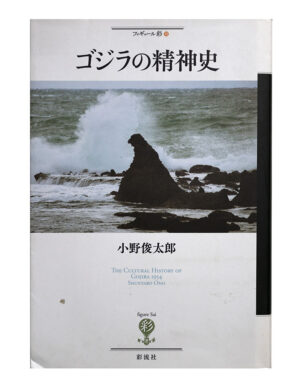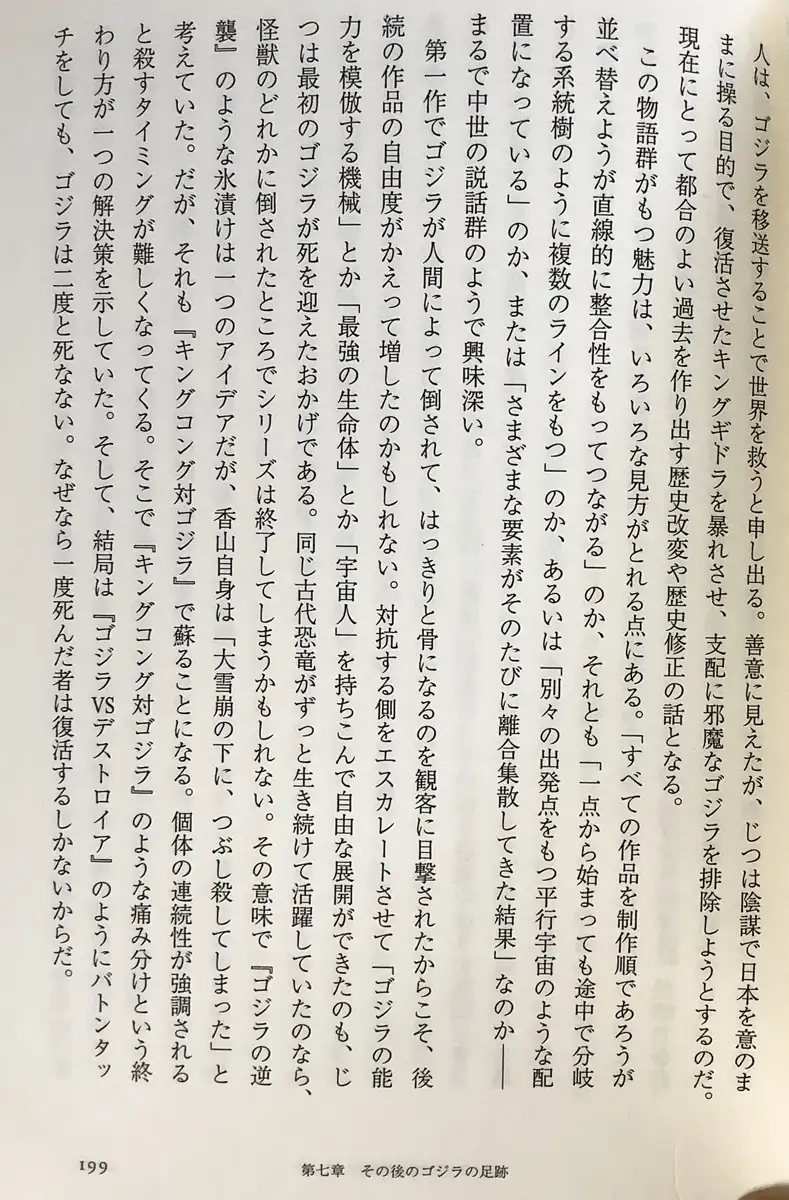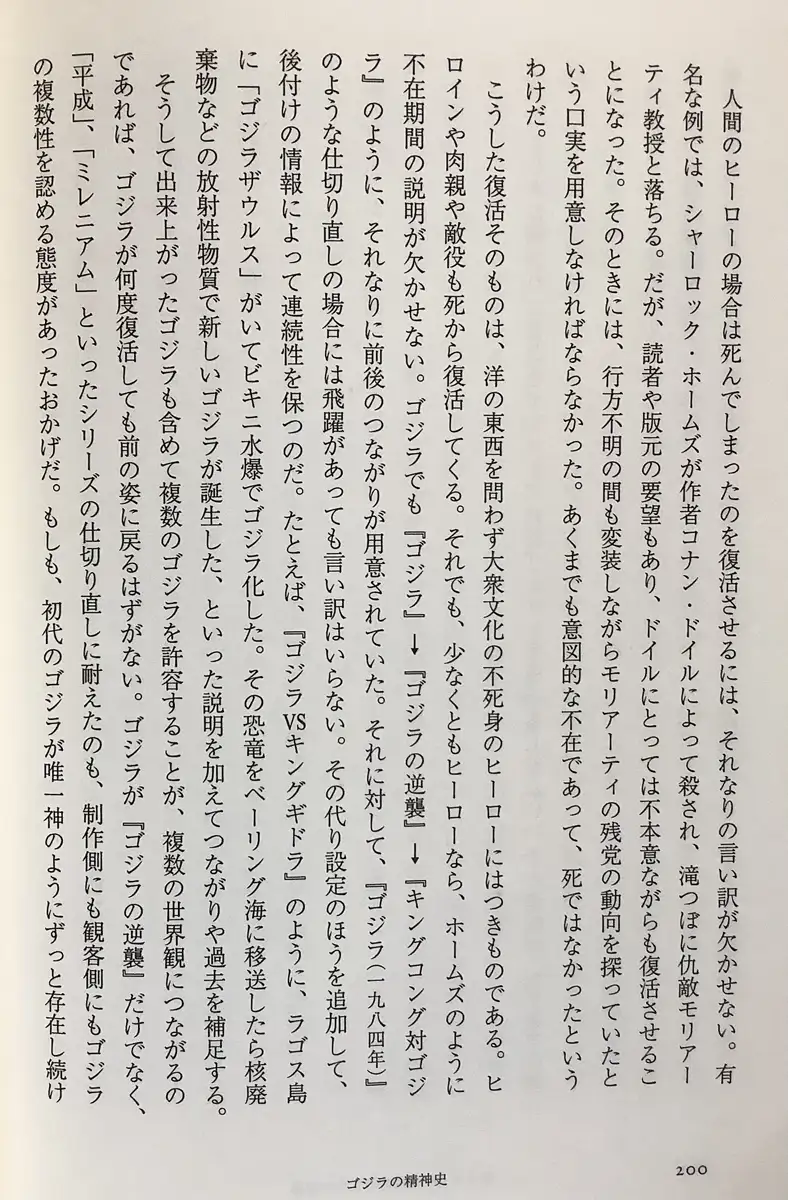9.22.2023
The Cultural History of Godzilla Introduction – Pt 72


P 198
表をつくろうとしてもあまり意味はない。ゴジラが単独なのか、複数なのか、という疑問は、じつは私たちの文化や歴史において、過去との連続または不連続をどう考えるのかという意識とつながる。それとともに、あちこちの土地がゴジラ戦争によって被害を受けた過去をどう解釈するのか、ということにもなる。昭和シリーズの被害地は平成シリーズでは関係ないということになる。だが、『ゴジラ』を東京の空襲と結びつけるのならば、大阪をはじめとしてゴジラが歩き回った全国いたるところに空襲の被害をうけた土地はあるのだ。
There is little point in trying to create a table. The question of whether there is one Godzilla or multiple Godzillas is actually connected to how we think about continuity or discontinuity with the past in our culture and history. At the same time, it also becomes a question of how to interpret the past, where many lands were damaged by Godzilla wars. This means that the damaged areas in the Showa series are irrelevant in the Heisei series. However, if we are to connect “GOJIRA” with the air raids on Tokyo, there are areas throughout the country where Godzilla roamed, including Osaka, that were damaged by air raids.
『ゴジラ』とその後のシリーズは、制作側の意図や狙いとは必ずしも関係なく、日本という社会やその歴史をどう考えるのかという意識とつながってきた。たとえば、昭和シリーズの『怪獣総進撃」(一九六八年)では、硫黄島は宇宙空港になるとされている。『ゴジラ』での最初の出現場所が硫黄島の近くであったことは第一章で指摘したとおりだが、そうした過去が未来志向の施設によって塗りつぶされてしまう。毎回のように建物が復興されている東京を始めとして、新しいイメージを敷き詰めて表面を舗装しなおすように、過去の地層にかぶせてしまうことがずっとおこなわれてきた。そのこと自体が、どこかで過去との真剣な対決を避けて、先延ばしにしてしまう私たちの習性ともつながっている。もちろん、忘れかけると過去の隠蔽を意識的に問いかける物語が現れてきたのも、じつはゴジラ物語群の魅力なのだ。
“GOJIRA” and the series that followed have nothing to do with the creator’s intentions or aims, but have been linked to an awareness of how to think about Japanese society and its history. For example, in the Showa series “Destroy All Monsters” (1968), Iwo Jima is said to become a space airport. As pointed out in Chapter 1, Godzilla’s first appearance was near Iwo Jima, but that past is erased by future-oriented facilities. Starting with Tokyo, where buildings are being rebuilt every time, new images have been laid over the past strata, as if re-paving the surface. This in itself is somehow connected to our tendency to avoid a serious confrontation with the past and postpone it. Of course, one of the charms of the Godzilla stories is that just as we begin to forget, stories that consciously question the concealment of the past emerge.
平成シリーズの『ゴジラVSキングギドラ』(一九九一年)では、日本軍が駐留していたマーシャル諸島のラゴス島にいたゴジラザウルスがビキニ水爆を浴びてゴジラになったという設定が出てくる。未来の二十三世紀にはゴジラが原発を破壊して日本が滅びている。そこからタイムワープをしてきた未来人は、ゴジラを移送することで世界を救うと申し出る。
In the Heisei series Godzilla vs. King Ghidorah (1991), Godzillasaurus, which was on Lagos Island in the Marshall Islands where the Japanese military was stationed, was exposed to a Bikini hydrogen bomb and became Godzilla. In the future, in the 23rd century, Godzilla destroys a nuclear power plant and Japan is destroyed. A person from the future who has time-warped from there offers to save the world by transporting Godzilla.

P 199
善意に見えたが、じつは陰謀で日本を意のままに操る目的で、復活させたキングギドラを暴れさせ、支配に邪魔なゴジラを排除しようとするのだ。現在にとって都合のよい過去を作り出す歴史改変や歴史修正の話となる。
It may seem like he has good intentions, but in reality, he uses a conspiracy to manipulate Japan to his will, causing the revived King Ghidorah to go on a rampage to eliminate Godzilla, who is in the way of his rule. This is a story about altering history and revising history to create a past that is convenient for the present.
この物語群がもつ魅力は、いろいろな見方がとれる点にある。「すべての作品を制作順であろうが並べ替えようが直線的に整合性をもってつながる」のか、それとも「一点から始まっても途中で分岐する系統樹のように複数のラインをもつ」のか、あるいは「別々の出発点をもつ平行宇宙のような配置になっている」のか、または「さまざまな要素がそのたびに離合集散してきた結果」なのかまるで中世の説話群のようで興味深い。
The appeal of this group of stories lies in the fact that they can be viewed in a variety of ways. Are all works connected in a straight line and with consistency, regardless of the order in which they were produced or rearranged, or do they have multiple lines like a family tree that branches off in the middle even if they start from one point? Is it “arranged like parallel universes with different starting points,” or “the result of various elements dispersing and dispersing each time?” It’s interesting, like a group of medieval fables.
第一作でゴジラが人間によって倒されて、はっきりと骨になるのを観客に目撃されたからこそ、後続の作品の自由度がかえって増したのかもしれない。対抗する側をエスカレートさせて「ゴジラの能力を模倣する機械」とか「最強の生命体」とか「宇宙人」を持ちこんで自由な展開ができたのも、じつは最初のゴジラが死を迎えたおかげである。同じ古代恐竜がずっと生き続けて活躍していたのなら、怪獣のどれかに倒されたところでシリーズは終了してしまうかもしれない。その意味で『ゴジラの逆襲』のような氷漬けは一つのアイデアだが、香山自身は「大雪崩の下に、つぶし殺してしまった」と考えていた。だが、それも「キングコング対ゴジラ」で蘇ることになる。個体の連続性が強調されると殺すタイミングが難しくなってくる。そこで『キングコング対ゴジラ」のような痛み分けという終わり方が一つの解決策を示していた。そして、結局は『ゴジラvsデストロイア』のようにバトンタッチをしても、ゴジラは二度と死なない。なぜなら一度死んだ者は復活するしかないからだ。
Perhaps it was precisely because the audience witnessed Godzilla being defeated by humans and clearly reduced to bones in the first film that subsequent films had more freedom. It was actually thanks to the death of the first Godzilla that they were able to escalate their opposition and bring in “machines that imitate Godzilla’s abilities,” “the strongest life forms,” and “alien.” If the same ancient dinosaur had been alive and active for a long time, the series might have ended if it was defeated by one of the monsters. In that sense, ice-packing like in “Godzilla Raids Again” was one idea, but Kayama himself thought “I crushed him to death under a huge avalanche.” However, that too will be revived in “King Kong vs. Godzilla.” When the continuity of individuals is emphasized, it becomes difficult to decide when to kill them. One solution to this problem was to end the story in a way similar to “King Kong vs. Godzilla,” where the pain was shared. And in the end, even if you pass the baton like in Godzilla vs Destoroyah, Godzilla will never die again. Because once someone dies, they have no choice but to be resurrected.

P 200
人間のヒーローの場合は死んでしまったのを復活させるには、それなりの言い訳が欠かせない。有名な例では、シャーロック・ホームズが作者コナン・ドイルによって殺され、滝つぼに仇敵モリアーティ教授と落ちる。だが、読者や版元の要望もあり、ドイルにとっては不本意ながらも復活させることになった。そのときには、行方不明の間も変装しながらモリアーティの残党の動向を探っていたという口実を用意しなければならなかった。あくまでも意図的な不在であって、死ではなかったというわけだ。
In the case of human heroes, a certain excuse is essential in order to revive a dead hero. In a famous example, Sherlock Holmes is killed by author Conan Doyle and falls into a waterfall with his nemesis Professor Moriarty. However, due to requests from readers and publishers, Doyle was reluctant to revive it. At that time, he had to come up with an excuse that he had been spying on Moriarty’s remnants while he was missing, disguised. His absence was intentional, and he was not dead.
こうした復活そのものは、洋の東西を問わず大衆文化の不死身のヒーローにはつきものである。ヒロインや肉親や敵役も死から復活してくる。それでも、少なくともヒーローなら、ホームズのように不在期間の説明が欠かせない。ゴジラでも『ゴジラ』『ゴジラの逆襲』->『キングコング対ゴジラ』のように、それなりに前後のつながりが用意されていた。それに対して、『ゴジラ(一九八四年)』のような仕切り直しの場合には飛躍があっても言い訳はいらない。その代り設定のほうを追加して、後付けの情報によって連続性を保つのだ。たとえば、『ゴジラVSキングギドラ』のように、ラゴス島に「ゴジラザウルス」がいてビキニ水爆でゴジラ化した。その恐竜をベーリング海に移送したら核廃棄物などの放射性物質で新しいゴジラが誕生した、といった説明を加えてつながりや過去を補足する。
This kind of resurgence is common to the immortal heroes of popular culture, both in the East and the West. The heroine, her immediate family, and even the villain come back from the dead. Still, at least if you’re a hero, like Holmes, it’s essential to explain your period of absence. Even in Godzilla, there were some connections before and after, like “Godzilla” and “Godzilla Raids Again” -> “King Kong vs. Godzilla.” On the other hand, in the case of a reboot like Godzilla (1984), there is no need for excuses even if there is a leap forward. Instead, they add settings and maintain continuity through retrofitted information. For example, in “Godzilla vs. King Ghidorah,” there was a “Godzillasaurus” on Lagos Island that was transformed into Godzilla by a Bikini hydrogen bomb. Add the explanation that a new Godzilla was born from radioactive materials such as nuclear waste when the dinosaur was transported to the Bering Sea, and supplement the connection and past.
そうして出来上がったゴジラも含めて複数のゴジラを許容することが、複数の世界観につながるのであれば、ゴジラが何度復活しても前の姿に戻るはずがない。ゴジラが『ゴジラの逆襲』だけでなく、「平成」、「ミレニアム」といったシリーズの仕切り直しに耐えたのも、制作側にも観客側にもゴジラの複数性を認める態度があったおかげだ。もしも、初代のゴジラが唯一神のようにずっと存在し続けていたなら、新しい作品の追加は不可能だっただろう。
If allowing multiple Godzillas, including the Godzilla created in this way, leads to multiple worldviews, then no matter how many times Godzilla is revived, there is no way he will return to his previous form. The reason that Godzilla endured not only “Godzilla Raids Again,” but also series revisions such as “Heisei” and “Millennium,” is because both the producers and the audience had an attitude that acknowledged Godzilla’s plurality. If the original Godzilla had continued to exist like the only god, it would have been impossible to add new works.